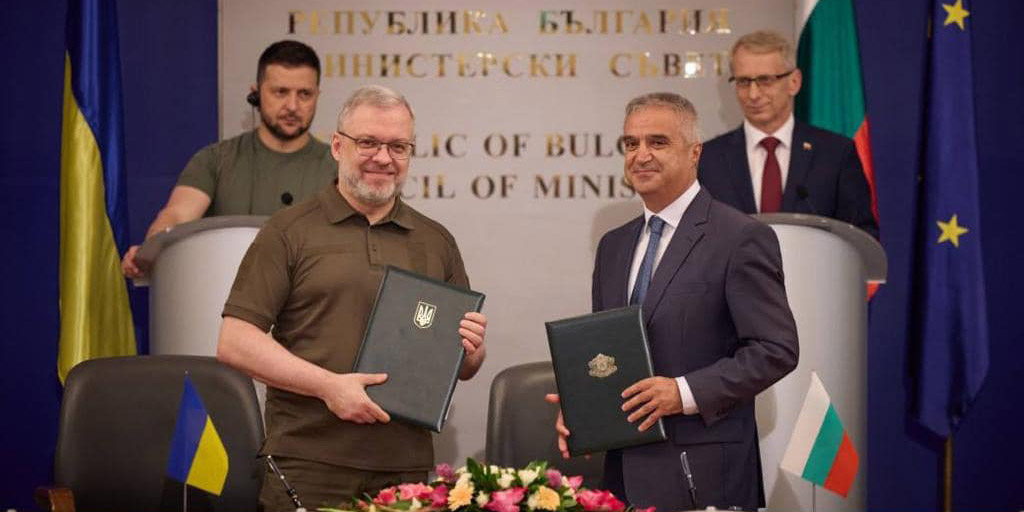The Khmelnitskiy nuclear power plant, site of Ukraine's planned new reactors. (Photo: RLuts)
Ukraine plans to start construction on four new nuclear plants this summer or fall, the country’s energy minister said in televised remarks today.
The quicker timeline aims to compensate Ukraine for lost energy capacity as its war with Russia continues. Ukraine’s government, however, still needs to sign off on the plans.
“We need vessels,” said energy minister German Galushchenko.
Westinghouse president and CEO Patrick Fragman (seated at left) and Energoatom president Petro Kotin (seated at right) sign an MOU on AP300 deployment in Ukraine. Standing behind Fragman and Kotin is Ukrainian energy minister German Galushchenko. (Photo: Energoatom)
Westinghouse Electric Company and Ukraine’s nuclear operator Energoatom have signed a memorandum of understanding on the development and deployment of the American firm’s AP300 small modular reactor in the Eastern European state.
In the foreground, from left: Ukrainian energy minister German Galushchenko and Bulgarian energy minister Rumen Radev at the MOU signing ceremony in Sofia, Bulgaria. Looking on are (from left) Ukrainian president Volodymyr Zelenskyy and Bulgarian prime minister Nikolai Denkov.
The energy ministries of Bulgaria and Ukraine have announced the signing of a memorandum of understanding to expand collaboration in the energy sector, including the nuclear energy sector.
The Rivne nuclear power plant, with Units 1 and 2 in the foreground. (Photo: Westinghouse)
Westinghouse Electric Company this week inked agreements with two of its European customers—Ukraine reactor fleet operator Energoatom and Bulgaria’s Kozloduy NPP–Newbuild, a firm established in 2012 to commission new nuclear power capacity at Kozloduy, Bulgaria’s only nuclear power facility.
Kris Singh (front left), Holtec International president and chief executive officer, signs the cooperation agreement between Holtec and Ukraine’s Energoatom, alongside other Holtec officials. (Photo: Holtec)
Small modular reactor developer Holtec International and Energoatom, Ukraine’s nuclear plant operator, signed a cooperation agreement last Friday that envisions the construction of up to 20 of the American firm’s SMR-160 units in Ukraine, with grid connection for the pilot project achieved by March 2029. In addition, the agreement calls for building a Ukrainian manufacturing facility to localize the production of equipment required for SMR-160 construction.
Rendering of a Rolls-Royce SMR plant. (Image: Rolls-Royce SMR)
The United Kingdom’s nuclear regulators—the Office for Nuclear Regulation (ONR), the Environment Agency, and Natural Resources Wales (NRW)—have announced the completion of step one of their generic design assessment (GDA) for Rolls-Royce SMR’s 470-MWe small modular reactor design and the start of step two, which is expected to last 16 months.
The Zaporizhzhia plant (Image: Energoatom)
As if being stuck in the middle of a combat zone isn’t sufficiently nerve-racking, workers at Ukraine’s Zaporizhzhia nuclear power plant—under Russian occupation since last March—must now concern themselves with having access to enough water to keep the facility safe.
The Rivne nuclear power plant in western Ukraine, home to four VVER pressurized water reactors. (Photo: Victor Korniyenko/Wikipedia)
In what it is calling a “major expansion” of its efforts to prevent a severe nuclear accident befalling Ukraine, the International Atomic Energy Agency yesterday announced that it is deploying teams of nuclear security and safety experts this week to the beleaguered nation’s nuclear power plants and the Chernobyl site. (The agency has already stationed a team of experts at Ukraine’s largest nuclear facility, the six-unit Zaporizhzhia plant, which has been under Russian military occupation since last March.)
U.S. special envoy for climate John Kerry at COP27. (Photo: Embassy of Ukraine in the United States of America)
U.S. special envoy for climate John Kerry and Ukraine’s minister of energy German Galushchenko have announced a two-to-three-year pilot project aimed at demonstrating the commercial-scale production of clean hydrogen and ammonia from small modular reactors in Ukraine using solid oxide electrolysis.
IAEA director general Rafael Mariano Grossi (at right) inspects damage at Ukraine’s Zaporizhzhia plant on September 1. (Photo: Fredrik Dahl/IAEA)
IAEA director general Rafael Mariano Grossi (center) with his team of nuclear safety, security, and safeguards experts at the Vienna International Airport on August 29, prior to their departure for Ukraine’s Zaporizhzhia nuclear power plant. (Photo: Dean Calma/IAEA)
After months of urgent entreaties to both the Ukrainian and Russian governments to allow the International Atomic Energy Agency access to the embattled Zaporizhzhia nuclear plant, IAEA director general Rafael Mariano Grossi yesterday set off for the facility, accompanied by a team of nuclear security, safety, and safeguards experts.
The Zaporizhzhia plant (Image: Energoatom)
Energoatom, Ukraine’s nuclear plant operator, is reporting that Units 5 and 6 at the Zaporizhzhia plant—currently the facility’s only operational reactors—were disconnected from the country’s power grid early in the morning of August 25.
The Zaporizhzhia site has been under the control of the Russian military since March 4, just days after Russia commenced its invasion of Ukraine.

















